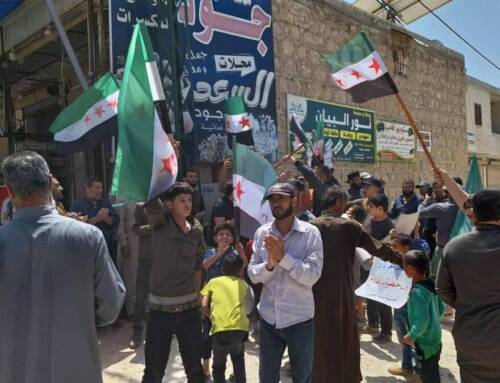East Ghouta protester: ‘If the UN continues to remain silent, it will be Assad’s partner in the killing’
Residents hold a sign that reads, “We welcome the UN, […]
24 February 2016

The Syrian Arab Red Crescent, accompanied by a UN delegation, arrived in an encircled rebel-held city in Damascus’s East Ghouta suburbs on Tuesday with 15 trucks carrying food and medicine for besieged residents.
But dozens of residents in the city of Kafr Batna welcomed the aid convoy with signs reading “UN=Assad,” protesting what they see as an unfair allocation of aid and the international body’s complacency in a regime plan to “sow discord” among inhabitants of East Ghouta.
“Kafr Batna’s residents expressed their anger over the aid distribution process to their town and not to the rest of East Ghouta,” Anas Abu Ayman, a journalist in Kafr Batna, told Syria Direct on Wednesday.
Located approximately 6km east of the Damascus city center, Kafr Batna is one of half a dozen overlapping, rebel-held suburbs that have been blockaded by regime forces for over three years.
Tuesday’s aid delivery of nine truckloads of food and six more of medical supplies to Kafr Batna was in accordance with a deal hammered out in Munich two weeks ago between dozens of countries, at their head the United States and Russia.
The agreement called for a “cessation of hostilities” within one week and stipulated the “sustained delivery of assistance” to seven blockaded areas and towns in Syria: Madaya, Deir e-Zor, Fuaa and Kafariya, Outer Damascus, Moadimiyet a-Sham, and Kafr Batna.
Last Wednesday, 100 SARC trucks delivered aid to all of the areas stipulated in the agreement except for rebel-controlled Kafr Batna and regime-held areas in Deir e-Zor besieged by Islamic State forces.
This week the Syrian Arab Red Crescent managed to deliver six truckloads of food to Kafr Batna, but it is only enough for approximately 40 percent of the 5,000 families in the town, and nothing was delivered to other parts of blockaded rebel East Ghouta, Yousef al-Bustani, an activist in Kafr Batna, told Syria Direct Wednesday.
This selective distribution of aid to only one suburb of East Ghouta is part of the regime’s larger plan to divide and conquer, said Abu Abdullah, a father of three children in Kafr Batna who didn’t receive an aid package despite admitting that he and residents of the town have resorted to eating vegetation to “satiate our children’s hunger.”
“The regime’s goal is for this aid delivery to sow discord between us,” Abu Abdullah told Syria Direct on Wednesday.
But residents’ anger with the UN stems from more than just selective aid deliveries.
“People of course were happy about the arrival of aid, but hunger is not the only killer,” said Abu Ayman, referencing continued regime airstrikes on residential areas in East Ghouta while the UN “remains silent.”
“During the demonstrations there was a clear message: If the UN continues to remain silent, it will be Assad’s partner in the killing of the Syrian people.”







